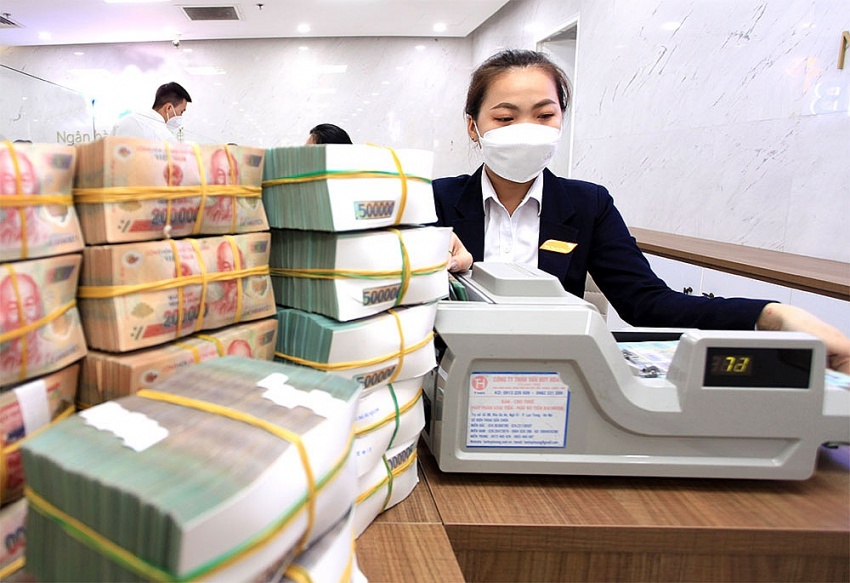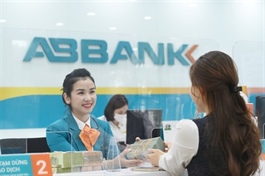Measures needed to increase capital absorption of firms
Measures needed to increase capital absorption of firms
It is critical to increase the capital absorption capacity of firms to promote economic growth, which will require a combination of solutions besides rate cuts, Deputy Governor of the State Bank of Việt Nam (SBV) Đào Minh Tú said at a conference on Tuesday.

To increase the capital absorption capacity of firms, interest rates should be reasonable, still, it is not a cure-all. — VNA/VNS Photo Trần Việt |
The conference was jointly held by the Thời Báo Ngân Hàng (Banking Times), the SBV and Việt Nam Association of Small and Medium Sized Enterprises to discuss solutions to increase the capital absorptive capacity for enterprises in the context of low credit growth and global and domestic economic headwinds.
Tú said that the global economy saw complex developments in the first half of this year with struggling production and trade, increasing geopolitical conflict, high inflationary risk and tightened monetary policies.
In the domestic market, economic growth was lower than the projected scenario, expanding at 3.72 per cent from January to June due to declining global demand and emerging internal economic problems, which was undermining the financial health and capital absorption capacity of enterprises.
He cited statistics that credit growth was low, only expanding at 4.73 per cent as of June 30. The goal for credit growth was set at 14 per cent for the full year.
All of these factors posed challenges to the economy and monetary policy management in particular. “Never before has monetary policy management been as difficult as this year. Raise rates or lower rates? Increase or decrease monetary supply? And how to ensure a balance between credit quality and credit growth to maintain national financial security?” Tú said.
Võ Trí Thành, director of the Institute for Brand and Competitiveness Strategy, said that the Vietnamese economy is facing significant challenges and uncertainties, including external factors such as global economic slowdown as well as internal problems.
Most forecasts were that the Vietnamese economy would grow below 5 to 5.5 per cent this year, which means that the target of 6 per cent GDP growth was challenging.
At the conference, Thành highlighted two headwinds to the Vietnamese economy. The first headwind was the global economic slowdown. The second headwind was the most difficult financial and monetary conditions ever.
Thành noted that the second headwind could potentially ease because inflation might reach its peak and could decrease faster than expected. However, it remained a major concern, particularly with the trend of rising prices of food as some countries started to food security measures.
To achieve the GDP growth target, besides expecting the recovery of the global economy, Việt Nam also needs to tackle the economy’s internal problems, including the effective implementation of the Government’s policies such as speeding up public investment disbursement, stimulating demand and improving the business climate to attract investment, Thành said.
He stressed that interest rates should be reasonable, still, it was not a one-size-fits-all solution. He urged comprehensive measures, including expanding the market for enterprises and offering new business opportunities.
According to Nguyễn Văn Thân, chairman of Việt Nam Association of Small and Medium Sized Enterprises (SMEs), about 25 per cent of the association’s member companies were facing difficulties in accessing credit, partly because the Government’s policies had not yet demonstrated consistency and businesses themselves had not proven their ability to recover capital.
To increase the capital absorptive capacity of enterprises, lowering rates was just a prerequisite.
Thân said in the long term, it was necessary to amend the Law on Supporting SMEs and create conditions for enterprises to restructure their production capacity and establish value chains.
Enterprises also need to improve their competitiveness, corporate governance capacity and financial transparency to be able to access credit, he added.
In the current context, if the loan conditions could not be easier, it was necessary to take measures to provide trust-based guarantees for SMEs, Thân said.
According to Kentut Ariadi Kussuma from the World Bank, the problem did not necessarily stem from enterprises' capacity to use money. “They don’t need to borrow,” he said.
He cited data from listed companies in the stock market which showed that there was still a lot of room to borrow but firms did not.
He also highlighted the danger of too many supply-side solutions in the environment of weak demand, pointing out that lower domestic rates in the context of higher global rates created pressure on Vietnamese đồng.
Besides, high credit growth in a weak demand environment could direct credit to non-productive sectors, which could lead to higher non-performing loans (NPLs) and financial instability.
“Rather than focusing on credit growth, it is more important to make sure credit flows into high-productivity sectors,” he said.
As Việt Nam aims to become a high-income country by 2045, it is important to consider diversifying policies away from the credit growth limit, he said, adding that the credit growth limit was effective during the upturn but less effective during the downturn.
The central bank could consider additional tools such as a capital buffer, dynamic provisioning, a loan-to-value cap or loan-to-income, he said.
A representative from the Bank for Investment and Development of Việt Nam (BIDV) said the comprehensive implementation of solutions was needed to increase the capital absorptive capacity for enterprises which would require effort from not only relevant ministries and management agencies but also banks and firms themselves.
The focus would be placed on effectively implementing the economic recovery and development programme, developing the capital market and strengthening the disbursement of public investment.
Firms should implement restructuring to ensure finance for core business efficiency and expand markets to reduce inventories.
According to Tú, any policies must be put into consideration for both medium-and-long term benefits because the lesson of NPLs in the previous period remained.
The central bank’s viewpoint was to continue to lower rates when there were favourable conditions for cuts, Tú said.
He urged commercial banks to cut operation costs to create room for further rate cuts.
In the first four months of this year, SBV slashed operating interest rates four times in the context of increasing inflationary risk and climbing rates in the global market.
Currently, lending rates were 0.5 to 2 per cent lower than at the end of 2022 with short-term rates for production and business loans at around 5 to 9 per cent per year and long-term rates at around 8.5 to 11 per cent per year.
|
Easier borrowing SBV said that some branches of foreign commercial banks in Việt Nam were stepping up to provide lending electronically. The Circular 06/2023/TT-NHNN dated June 26 and to take effect from the beginning of September added regulations about lending through electronic means to create favourable conditions for credit institutions to implement electronic lending activities with safety and efficiency. This provision aims to encourage credit institutions to apply technology and digital transformation in lending, thereby shortening procedures and processes, and making it easier and more convenient for customers to access loans without having to visit the banks. SBV also said that the circular had changed many provisions to create favourable conditions for customers to access banking credit, including simplifying procedures, allowing customers to borrow without a plan, allowing customers to borrow at one credit institution to repay loans at others and borrowing for personal needs. |



















